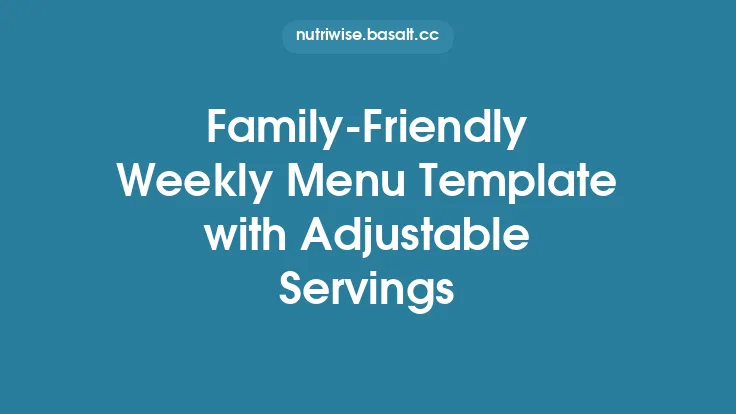When it comes to turning a weekly menu into a smooth, stress‑free dinner routine, the magic lies not in any single gadget or storage hack but in the choreography of each step—from the moment an idea lands on your mind to the final bite on the plate. By treating the kitchen as a production line and applying a few disciplined habits, you can shave minutes off prep, eliminate last‑minute grocery trips, and enjoy more time at the table. Below is a comprehensive, evergreen guide that walks you through every phase of the workflow, offering practical tactics you can adopt today and refine over the years.
Crafting an Effective Meal Plan
A solid meal plan is the blueprint that keeps the rest of the process from spiraling into chaos.
- Set a Planning Horizon – Choose a timeframe that matches your lifestyle. Most people find a 7‑day cycle ideal because it aligns with grocery store restock schedules and provides enough variety without overwhelming the mind.
- Balance Nutrition and Variety – Use a simple spreadsheet or a printable template with columns for protein, vegetables, grains, and a “theme” (e.g., Italian night, quick stir‑fry). Aim for at least two different protein sources per week and rotate vegetables to cover a broad spectrum of micronutrients.
- Account for Time Constraints – Flag meals that require ≤30 minutes of active cooking for busy weekdays, and reserve longer, more involved recipes for weekends or evenings when you have extra bandwidth.
- Incorporate Repeating Elements – Identify base components (e.g., roasted chicken, cooked quinoa, sautéed greens) that can be repurposed across multiple dishes. This “ingredient pooling” reduces the number of unique items you need to purchase and prepares you for quick assembly later.
- Build in Flexibility – Leave one or two slots open for “leftover night” or “spontaneous dinner.” This buffer prevents the plan from feeling rigid and gives you room to adapt to unexpected events.
Translating Plans into Precise Shopping Lists
A well‑structured list is the bridge between the mental plan and the physical store.
- Categorize by Store Section – Even though we’re not focusing on pantry organization, grouping items by the aisle (produce, meat, dairy, dry goods, frozen) cuts down on back‑and‑forth movement and reduces the chance of missed items.
- Quantify Exactly – Instead of “chicken breasts,” write “4 × 6‑oz boneless, skinless chicken breasts.” For bulk items, note the required weight (e.g., “1 lb carrots”). Precise quantities prevent over‑buying and minimize waste.
- Use a Master Inventory Sheet – Keep a running list of staple items you already have (e.g., olive oil, spices, canned beans). Before finalizing the weekly list, cross‑reference to avoid duplicate purchases.
- Leverage Digital List Apps – Apps that sync across devices let you add items on the fly while at work or on the go. Many also allow you to check off items in real time, which is especially handy for shared household shopping.
- Add “Prep‑Ready” Notes – Include brief instructions next to each ingredient if it requires pre‑processing (e.g., “pre‑wash and trim 1 lb green beans”). This reminder saves a step later in the kitchen.
Optimizing Your Grocery Run
Even with a perfect list, the actual trip can become a time sink if not approached strategically.
- Choose the Right Shopping Time – Early mornings on weekdays or late evenings on weekends typically see fewer shoppers, shorter checkout lines, and fresher produce.
- Map the Store Layout – Familiarize yourself with the store’s flow. Even a quick mental map of where each category resides can shave several minutes per aisle.
- Batch Similar Tasks – If you need to pick up a few items from the deli, bakery, and frozen sections, collect them in one pass rather than revisiting each department.
- Utilize Self‑Checkout for Small Baskets – For a concise list, self‑checkout can be faster than waiting for a full‑service lane, especially when you already have a digital list that can be scanned.
- Inspect Produce Efficiently – Use a “quick‑scan” method: check color, firmness, and any signs of bruising in a systematic left‑to‑right motion. This reduces the time spent lingering over each item.
Pre‑Prep Strategies to Save Time
The work that happens before you turn on the stove often determines how smooth the cooking phase will be.
- Batch Wash and Dry – Allocate a single 15‑minute window to wash all vegetables for the week. Use a salad spinner or a clean kitchen towel to dry them quickly, then store in airtight containers.
- Pre‑Portion Proteins – Divide meat, fish, or plant‑based proteins into individual serving sizes and label with the intended recipe. This eliminates the need to measure out portions during the heat‑up.
- Create Base Sauces in Advance – Cook a large batch of tomato sauce, pesto, or curry base on the weekend. Store in portion‑size jars; they can be reheated in minutes and serve as the flavor foundation for multiple meals.
- Utilize the “Cold‑Prep” Method – For dishes like salads, grain bowls, or marinated proteins, assemble the components the night before and keep them refrigerated. This reduces active cooking time to a simple assembly step.
- Set Up a “Staging Area” – On the countertop, arrange all pre‑pped ingredients in the order they will be used. This visual cue acts like a production line, ensuring you never have to hunt for a missing component mid‑cook.
Sequencing the Cooking Process
Even a well‑planned menu can become chaotic if the cooking steps are not ordered logically.
- Identify Overlapping Tasks – List each recipe’s active (stirring, sautéing) and passive (simmering, baking) steps. Look for opportunities where a passive step in one dish coincides with an active step in another.
- Prioritize Heat‑Intensive Steps – Start with dishes that require the oven or stovetop at high temperatures, as they often need the longest pre‑heat or cooking time.
- Use a “Timer Stack” – Set multiple timers on a single device, each labeled with the dish and step (e.g., “Quinoa – 15 min”). This visual stack helps you keep track of overlapping cooking windows without mental juggling.
- Employ the “One‑Pot” Philosophy When Possible – Consolidating multiple components into a single pot or pan reduces the number of dishes to clean and streamlines flavor development.
- Finish with Fresh Elements – Reserve raw herbs, a squeeze of citrus, or a drizzle of oil for the final plating. Adding these at the end preserves brightness and prevents over‑cooking delicate flavors.
Integrating Batch Cooking and Freezing
Batch cooking is a cornerstone of a streamlined workflow, allowing you to pull a complete meal from the freezer in minutes.
- Select Freezer‑Friendly Recipes – Stews, chilis, casseroles, and grain‑based salads freeze well. Avoid dishes with high water content vegetables (e.g., lettuce) that become soggy after thawing.
- Standardize Portion Sizes – Use a kitchen scale to portion meals into 250‑g or 350‑g servings. Uniform portions thaw evenly and simplify reheating times.
- Label with Date and Content – Even though labeling systems are a separate topic, a simple handwritten note with the date and dish name on each container is essential for food safety and rotation.
- Employ Rapid‑Thaw Techniques – For meals you need within an hour, place the sealed container in a bowl of cold water, changing the water every 15 minutes. This method is faster than refrigerator thawing and preserves texture better than microwave defrost.
- Reheat Using the “Low‑and‑Slow” Method – When possible, reheat on the stovetop over low heat, stirring occasionally. This prevents scorching and ensures even temperature distribution, especially for sauces and soups.
Leveraging Technology for Seamless Workflow
Digital tools can act as the nervous system of your kitchen, coordinating each stage with minimal friction.
- Meal‑Planning Software – Platforms like Paprika, Mealime, or Yummly let you import recipes, generate shopping lists automatically, and sync across devices. Many also suggest ingredient substitutions based on what you already have.
- Smart Grocery Lists – Voice assistants (e.g., Alexa, Google Assistant) can add items to your list on command, freeing you from manual entry while you’re cooking or shopping.
- Timer and Reminder Apps – Use a dedicated kitchen timer app that supports multiple concurrent timers with custom labels and audible alerts. Some apps integrate with smart speakers for hands‑free operation.
- Inventory Tracking Spreadsheets – A simple Google Sheet with columns for item, quantity, purchase date, and expiration can be updated on the fly via your phone. Conditional formatting can highlight items nearing their “use‑by” date.
- Recipe Scaling Calculators – Online calculators let you adjust ingredient quantities on the fly, which is handy when you need to double a batch for leftovers or halve a recipe for a quick weekday dinner.
Managing Leftovers and Reducing Waste
An efficient workflow doesn’t end when the plates are cleared; it extends into how you handle what’s left.
- Designate a “Leftover Box” – Keep a set of clear, stackable containers in the fridge for immediate leftovers. Label each with the date and intended use (e.g., “Monday lunch – quinoa bowl”).
- Transform Leftovers Into New Meals – A roasted vegetable medley can become a filling for tacos, while cooked chicken can be shredded for salads or soups. Planning for these transformations during the initial meal‑plan stage prevents waste.
- Implement a “First‑In‑First‑Out” Routine – When you add a new batch of a staple (e.g., cooked rice), place it behind the older batch. This visual cue ensures older food gets used before it spoils.
- Utilize the “Freezer‑First” Rule for Perishables – If you know you won’t use fresh herbs within a few days, chop and freeze them in ice‑cube trays with a splash of oil or broth. This preserves flavor and eliminates the need to discard wilted greens.
- Track Waste Metrics – Periodically record the weight or volume of food discarded. Over time, you’ll spot patterns (e.g., over‑buying certain produce) and can adjust your planning accordingly.
Post‑Meal Cleanup and Resetting for Tomorrow
A tidy workspace is the final piece that ensures the next cooking session starts on a clean slate.
- Adopt the “Clean‑As‑You‑Go” Habit – While a sauce simmers, wash the cutting board and knives used for the preceding prep. This prevents a mountain of dishes at the end.
- Use a “Reset Tray” – Keep a small tray near the sink for items that need a quick rinse (e.g., measuring cups, silicone spatulas). Once the tray is full, give it a swift wash and return the tools to their proper spots.
- Wipe Down Surfaces Immediately – Spills on countertops or stovetops can harden and become harder to clean later. A damp cloth or spray cleaner used right after cooking keeps surfaces spotless.
- Inspect and Restock for the Next Day – Before you finish, glance at your inventory sheet and note any items that need replenishing. Add them to a “tomorrow’s list” so the next shopping trip is already partially prepared.
- Set a Quick “End‑Of‑Day” Timer – Allocate a fixed 10‑minute window for final cleanup. Knowing there’s a set limit helps you stay focused and prevents the task from dragging on indefinitely.
By treating each phase—from the initial menu brainstorm to the final kitchen wipe‑down—as a linked component of a larger system, you transform meal preparation from a series of isolated chores into a fluid, repeatable process. The result is more consistent nutrition, less stress, and a kitchen that works for you, not the other way around. Implement these steps gradually, refine them to suit your household’s rhythm, and you’ll find that the journey from shopping list to dinner plate becomes not just efficient, but genuinely enjoyable.





